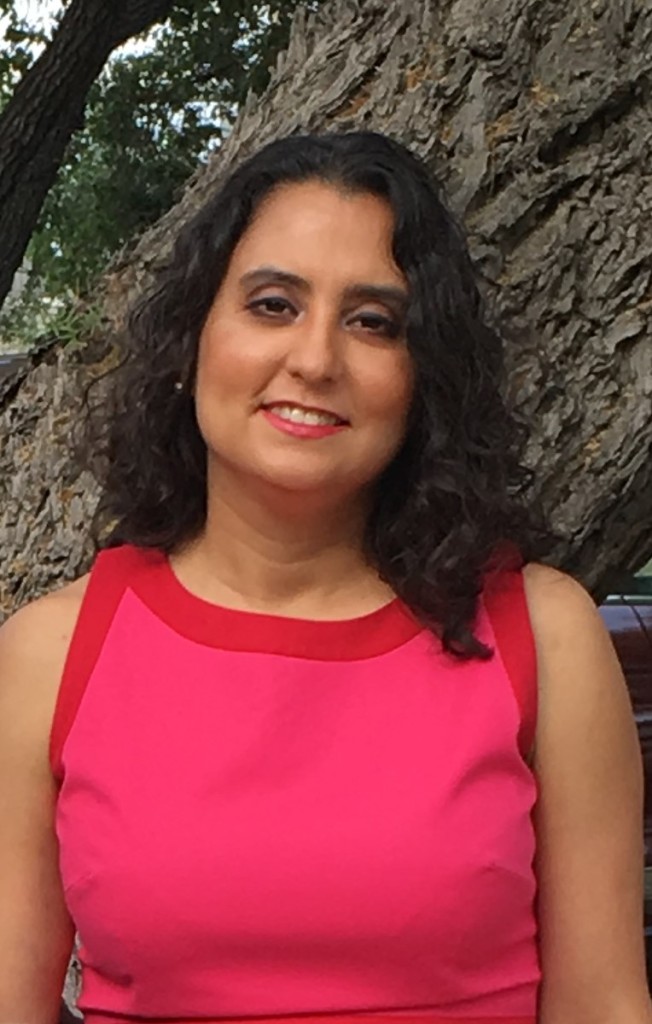There we stood by the stage outside the St. Augustine Cathedral in Laredo, Texas, dressed in full costume. All my dancers and I were waiting our turn to perform at their Jamaica. Suddenly the bells rang indicating that mass had ended. As the churchgoers exited the building they walked right next to us as we stood by the stage. The priest came out of the church and walked all around us blessing us with holy water. Sprinkles of water touched my arms, dress, and head. Then, the priest got up on stage and welcomed everyone with a prayer. As we bowed our heads, I spoke silently to God thanking him with all my heart. Then, I prayed to God dedicating these dances to Him. Just then, the organizer gave us the cue to begin. I took the stage performing the dances of Costa Chica, Guerrero with my dance group. We danced in front of the cathedral, before parishioners, family, friends and God.
Embodying God through Folklorico Dance
As folkloristas, we are used to thinking of the danzas (indigenous ritual and ceremonial dances) as a form of prayer but not the bailes (social dances as performed at parties, festivals, and ballrooms). [i] I argue that the social dances as performed by folklorico groups in 21st century United States are a form of prayer when accompanied by mindful thoughtful, reflection as directed by our spirit. Nowadays, we perform the dances of Guerrero, Jalisco, Veracruz, Sinaloa, etc., to honor the Virgen Mary, at Church Festivals, at cemeteries for Dia de los Muertos, and my dancers even performed at a rosary to honor my aunt who passed away. (see my post Bodily Memories) Not to mention that there are many folklorico groups that are affiliated with the Catholic Church. When we dance we embody God’s love with every movement.
How is Dance Prayer?
Yet, what does it mean to dance as a form of prayer? When we believe that our movements, life, and existence is because of God, then we can understand how powerful Dance truly is. Dance is very powerful because it allows for careful reflection (Bessett 230). All life is rooted in movement. Dance becomes prayer when our soul is guides us towards God. This prayer begins from our inner soul and radiates outward to our bodies as we move and execute our dance movements (De Sola 10). As we perform the social dances of Mexico such as Jalisco, Veracruz, and Guerrero to name a few we express our gratitude and love of God. We bodily pray to God with every zapateado, skirt flourish, and grito. Yes, our soul guides us to pray through movement.
Thus, as folkloristas it is time for us to think “outside the box.” We need to re-define the ways in which we look at these social dances as we perform them in the 21st century United States. It is true that these dances tell us about our cultural history. They are also forms of prayer when we are in thoughtful reflection as directed by our spirit. In what ways has dancing folklorico especially the social dances of Mexico served to strengthen your faith?
Works Cited
Bessette, Ona B. “Dance as Prayer: Moving the Body to Stir the Soul.” Catholic Education A Journal of Inquiry and Practice 3.2 (2013). 225-236. Print.
De Sola, C. The Spirit Moves: Handbook of Dance and Prayer. The Sharing Company, 1977. Print.
Nájera-Ramírez O., Norma E. Cantú and Brenda M. Romero, Ed. Dancing Across Borders: Danzas y Bailes Mexicanos.Chicago: University of Illinois Press, 2009. Print.
[i] Please read the book Dancing Across Borders: Danzas y Bailes Mexicanos for a definition of the words danza and baile.
All photos courtesy of Gabriela Mendoza-Garcia

Gabriela Mendoza-García Ph.D. is an Artist and Scholar. She has her own dance school and company called the Gabriela Mendoza-García Ballet Folklórico in Laredo, Texas. Dr. Mendoza-Garcia founded this group in 2013 and teaches children and adults of all ages. Her company consists of seasoned folklórico dancers with years of experience performing this art form. She teaches traditional Mexican folklórico dance pieces, as well as, works that are inspired by her scholarly research. Her scholarship includes: Dancing throughout Mexican History (1325-1910), History & Folklore booklet with an accompanying documentary sponsored by the Webb County Heritage Foundation, The Jarabe Tapatío: Imagining Race, Nation, Class and Gender in 1920s Mexico published by Oxford University Press, an on-line blog, writings for Asociación Nacional de Grupos Folklóricos, and others.


